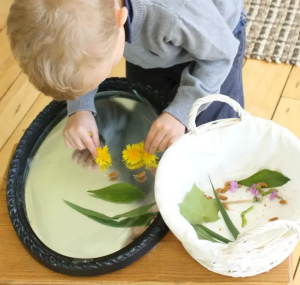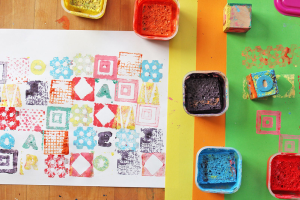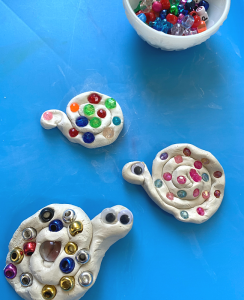Discover 23 cool clay activities for preschoolers to keep little hands busy with fun, imaginative, and educational sculpting projects.
Whether they’re squishing, molding, or shaping, clay activities offer a hands-on experience that enhances fine motor skills, cognitive development, and sensory integration.
It’s malleable texture and vibrant colors provide endless possibilities for preschoolers to explore and express themselves.
We will delve into fun & easy clay activities for preschoolers, guaranteeing hours of fun and educational playtime.
So, get ready to dive into the world of clay with your little ones and watch their creativity come to life!
Clay Color Mixing:

Let your preschoolers explore the wonders of color by engaging them in a clay color mixing activity. Provide them with primary-colored clay (red, blue, and yellow) and encourage them to experiment with combining different colors to create new shades and hues. As they knead, roll, and blend the clay together, they’ll witness the fascinating transformation of colors. This activity not only enhances their understanding of color theory but also develops their fine motor skills as they manipulate the clay. Plus, it’s a great opportunity to introduce basic vocabulary related to colors and encourage their verbal expression as they describe the colors they create.
Nature Impressions:

Take your preschoolers on a nature-inspired adventure by incorporating natural materials into their clay activities. Head outdoors and collect leaves, flowers, and twigs of various shapes and sizes. Back indoors, provide them with soft clay and encourage them to press these natural items onto the clay’s surface, leaving beautiful imprints. As they explore the different textures and patterns, they’ll develop their sensory perception and observation skills. Additionally, this activity fosters an appreciation for nature and allows them to create unique artworks inspired by the world around them.
Clay Puzzles:

Engage your preschoolers in a playful and educational activity by creating clay puzzles. Start by rolling out a flat piece of clay and cutting it into various shapes using cookie cutters or freehand shapes. Then, divide each shape into two or more pieces using a plastic knife or clay tools. Mix up the pieces and let your little ones solve the puzzle by assembling the shapes back together. This activity enhances their problem-solving skills, hand-eye coordination, and spatial awareness. Moreover, they’ll have a blast manipulating the clay pieces and creating their own mini-masterpieces.
Related: 20 Helpful Grief Activities for Elementary Students
Clay Ice Cream Shop:

Unleash your preschoolers’ creativity by setting up a clay ice cream shop. Provide them with different colored clay and shape them into ice cream scoops, cones, and toppings. Encourage them to create their own imaginative flavors and combinations. They can even use small craft sticks or toothpicks to simulate ice cream cones. This activity promotes imaginative play, fine motor skills, and social interaction as they take turns being customers and servers in their very own ice cream parlor. You can extend the fun by incorporating pretend money or even creating a clay bakery or pizza parlor for more imaginative adventures.
Clay Story Starters:

Foster your preschoolers’ storytelling skills by introducing clay story starters. Begin by shaping different clay characters, animals, or objects relevant to a story theme, such as a farm, a zoo, or a jungle. Place these clay creations in a basket and encourage your little ones to pick one or two pieces. They then have to use their imagination to create a story incorporating the chosen clay items. This activity stimulates their language development, creativity, and narrative skills. It’s a fantastic way to engage their minds and let their imaginations soar as they bring their stories to life with clay as their storytelling medium.
Related: 20 Brilliant Eye Contact Games for Kids
Clay Sensory Bags:

Create a sensory experience for your preschoolers by making clay sensory bags. Take a sturdy sealable plastic bag and fill it with a small amount of colorful clay. Seal the bag tightly and let your little ones manipulate and squish the clay through the bag. They can explore the different textures and observe how the colors mix and blend. This activity promotes sensory integration, fine motor skills, and tactile exploration in a mess-free way.
Clay Nature Sculptures:

Encourage your preschoolers to become little sculptors with this nature-inspired clay activity. Head outdoors and let them collect small natural objects like pebbles, acorns, pinecones, and seashells. Back inside, provide them with clay and let their creativity flow as they use these natural treasures to create unique sculptures. This activity helps them develop their fine motor skills, hand strength, and spatial awareness while fostering an appreciation for the beauty of nature.
Clay Alphabet Hunt:

Combine the excitement of a treasure hunt with the joy of working with clay in this educational activity. Write down the letters of the alphabet on small pieces of paper and hide them around the play area. Once the letters are found, preschoolers can use clay to mold each letter they’ve discovered. This activity reinforces letter recognition and fine motor skills while adding an element of excitement and discovery to learning the alphabet.
Clay Stamp Art:

Introduce your little artists to the world of stamping with clay. Offer them various textured materials like rubber stamps, foam shapes, and household items like bottle caps or lids. They can press these objects onto soft clay to create captivating patterns and designs. This activity enhances their creativity, introduces them to different textures, and improves their hand-eye coordination as they aim to make precise impressions with the stamps.
Clay Snakes and Beads:

This activity combines clay sculpting with a fun and educational counting game. Provide your preschoolers with colorful clay and instruct them to shape the clay into snakes of varying lengths. Once the snakes are formed, they can add small clay beads onto each snake, counting as they go. This interactive activity promotes numeracy skills and hand strength while fostering their imagination as they design and decorate their clay creatures.
Clay Emotion Faces:

Help your preschoolers explore emotions and feelings through clay in this expressive activity. Provide them with a range of colored clay and encourage them to sculpt different facial expressions like happy, sad, surprised, and angry. As they create these emotion faces, discuss each emotion, what it means, and when they might feel that way. This activity aids emotional intelligence development, encourages open communication, and provides a safe space for children to express and understand their feelings.
Clay Texture Exploration:

Engage your preschoolers’ sense of touch and creativity with a clay texture exploration activity. Provide them with different textured materials such as fabric scraps, bubble wrap, ribbons, and plastic mesh. Let them press these materials onto the clay’s surface, creating interesting textures and patterns. They can experiment with combining textures and see how each material leaves a unique imprint. This activity stimulates their sensory development, fine motor skills, and artistic expression as they explore the tactile qualities of clay.
Clay Shape Sorting:

Enhance your preschoolers’ shape recognition skills with a clay shape sorting activity. Using different colored clay, mold various geometric shapes such as circles, squares, triangles, and rectangles. Spread them out on a table and invite your little ones to sort the shapes into corresponding groups. They can also create matching clay shapes by rolling the clay into balls and flattening them into the desired shapes. This hands-on activity promotes shape identification, fine motor skills, and critical thinking as they classify and match the clay shapes.
Clay Story Stones:

Spark your preschoolers’ storytelling abilities with clay story stones. Provide them with smooth, flat stones and colorful clay. Encourage them to mold clay characters, objects, and scenes on the stones that relate to a specific story or theme. Once the clay has hardened, they can use the story stones as visual aids while retelling stories or creating their own imaginative tales. This activity nurtures their storytelling skills, enhances their creativity, and fosters their oral language development.
Clay Sculpture Garden:

Transform your preschoolers’ play area into a clay sculpture garden. Offer them a variety of clay colors and challenge them to create sculptures inspired by nature, such as flowers, trees, animals, and insects. They can use their hands or clay tools to shape and mold the clay into their desired forms. Arrange the sculptures in a designated garden area and encourage your little ones to explore and admire their clay masterpieces. This activity cultivates their artistic expression, imagination, and appreciation for the beauty of the natural world.
Clay Sensory Bin:

Create a sensory-rich experience for your preschoolers with a clay sensory bin. Fill a large container with soft clay, incorporating different colors to make it visually appealing. Add various sensory items like seashells, small toys, textured balls, and plastic animals. Let your little ones explore the bin freely, engaging their senses of touch, sight, and sound. They can squish, mold, and manipulate the clay while discovering hidden treasures within. This sensory activity supports their fine motor skills, sensory integration, and cognitive development as they engage in open-ended play.
Clay Pattern Making:

Encourage your preschoolers to explore patterns with clay. Provide them with different colored clay and various pattern-making tools like rollers, stamps, and textured objects. Show them how to create patterns by rolling the clay in different directions or pressing the tools onto the clay’s surface. They can experiment with repeating patterns, alternating colors, or creating their own unique designs. This activity enhances their pattern recognition skills, fine motor coordination, and artistic creativity.
Clay Collage Art:

Combine clay and collage techniques to create unique artwork. Give your preschoolers a base such as a small canvas or cardboard. Provide them with soft clay in various colors and instruct them to create shapes, objects, or characters. They can then press the clay pieces onto the base, overlapping and layering them to form a collage. Encourage them to explore different textures and colors, allowing their imaginations to guide their creative process. This activity fosters their artistic expression, fine motor skills, and visual-spatial awareness.
Clay Fossils:

Take your preschoolers on a journey back in time with a clay fossil activity. Begin by discussing fossils and how they provide clues about ancient life. Provide your little paleontologists with soft clay and plastic dinosaur or animal figures. Encourage them to press the figures into the clay to create imprints, mimicking the formation of fossils. They can then remove the figures, leaving behind their “fossil” imprints. This hands-on activity sparks their curiosity about history, encourages imaginative play, and introduces scientific concepts.
Clay Sensory Bracelets:

Engage your preschoolers’ senses and fine motor skills by creating clay sensory bracelets. Cut small strips of clay in different colors and provide them with beads, buttons, or small objects with interesting textures. Show them how to roll the clay strips into bracelets and encourage them to press the beads or objects onto the surface. As they wear the bracelets, they can enjoy the tactile experience of the different textures. This activity stimulates their sensory exploration, hand strength, and creativity.
Clay is more than just a craft material, it’s a gateway to creativity, learning, and sensory play. These 23 cool clay activities for preschoolers are designed to engage young minds while building fine motor skills and encouraging artistic expression.
Whether you’re a teacher, parent, or homeschooler, these fun ideas are perfect for tiny hands and big imaginations!


